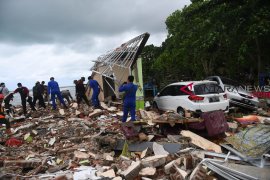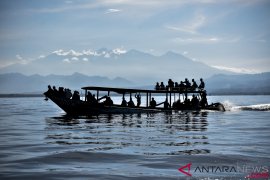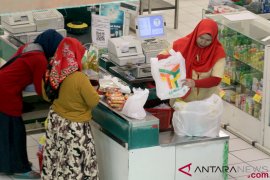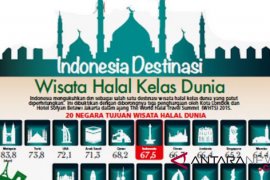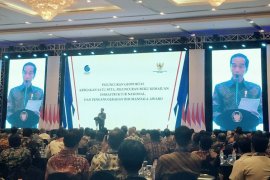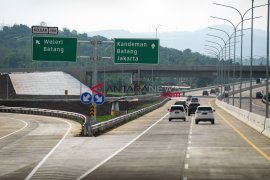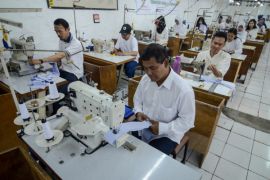"The government needs to fix its logistical distribution system before it enters the AEC in 2015."Jakarta (ANTARA News) - The government is determined to expand seaports across Indonesia in a bid to set in motion the Master Plan for Acceleration and Expansion of Indonesia`s Economic Development (MP3EI), promulgated for developing public infrastructure throughout the country.
The plan has been proposed in the wake of concerns expressed about the inadequate seaport facilities provided by the government. Importers have pointed out that the services available at Indonesian ports are still insufficient and prohibitively expensive.
"If port conditions are not improved soon, the government will continue to face resistance in its attempt at encouraging the nation's industry to raise its competitive edge," Achmad Ridwan, the secretary of the Indonesian Importers Association (GINSI) said recently.
Indonesia being an island country has to develop a reliable and efficient logistical distribution system at its seaports, which will boost the country's economy and make Indonesia an economic power to be reckoned with in the Asia.
"The government needs to fix its logistical distribution system before it enters the ASEAN Economic Community (AEC) in 2015, " Ridwan stated.
Meanwhile, the government already has a blueprint for initiating the developmental work at seaports in the country, including those that will be a part of the MP3EI infrastructure development programmes.
Developing the around 1900 seaports in the country, will require considerable funds, and should therefore be carried out in stages.
Leon Muhammad, the Secretary of the Directorate General of Sea Transportation, estimates that the government will need at least Rp439.67 trillion or US $46.112 million for the development of the seaports across the country, which is expected to be completed by 2030.
However, the government does not plan to bear the entire cost of this project and is hoping to attract additional capital from private investors. As of now, the government can only allocate up to US $14.618 million for the project, which only makes up for about 31.7 percent of the total needed for completion.
"The remaining US $31.499 million are expected to be sourced from foreign investors," Muhammad added.
Seaports, which are included in the MP3EI alone, will need an investment of Rp117 trillion.
"We plan to invest Rp117 trillion for the expansion of seaports in the country," Deputy Minister for Transportation Bambang Susantono said, adding that even though the budget of Rp117 trillion seems like a big commitment to make at present, it is a very small portion of the total expenditure needed for developing all the ports spread across the country.
Therefore, the government needs to prioritize which ports should be revamped first as a locomotive or as a gateway, he added.
Muhammad pointed out that the Indonesian government began its port expansion project in 2011 to support its MP3EI programme.
"We expect that for the 2011 to 2015 period, the investment required for port expansion projects should be around US $12.114 billion, but the government is ready to only spend US $5.148 million, which is about 42.5 percent of the total funding required," he noted.
He added that the remaining 57.5 percent or US $6.966 million will be obtained from the private sector.
"The government's role in developing the ports of Indonesia will continue to decrease as we get closer to 2030, while that of the private sector will gradually increase," Muhammad stated.
Indonesia currently has 1,978 ports, which consist of 111 commercial, 614 non-commercial, 472 special terminal and 721 private terminal seaports.
Muhammad also acknowledged the underlying challenge for the Indonesian government in trying to source huge investment for developing and making its ports efficient. At present, the government is expanding the main seaports of Indonesia, which are located in North Sumatra, Aceh, Tanjung Priok and Tanjung Perak in Java, Makassar in South Sulawesi and Bitung and Sorong in Papua.
"These are strategic seaports and enjoy a close proximity to international shipping routes," Muhammad asserted.
The government is also developing container terminal ports in Kalibaru at the Tanjung Priok port, at Teluk Lamong in East Java and a container terminal at the Belawan port in North Sumatra.
Meanwhile, in the next five years, the government plans to expand at least 26 seaports, which include the port of Pontianak in West Kalimantan, Batam in Riu Islands, Madura in East Java, Cilamaya and Palembang in South Sumatra, Kuala Tanjung in North Sumatra, Panjang in Lampung, Ambon in Maluku, Dumai in Riau, Teluk Bayur in West Sumatra, Makassar in South Sulawesi, Banjarmasin in South Kalimantan, Bitung in North Sulawesi, Tanjung Emas in Semarang, Probolinggo in East Java, Balikpapan in East Kalimantan, Jayapura and Sorong in Papua, Pleihari in South Kalimantan, Sei Gintung, Gorontalo and Pantoloan in Central Sulawesi, and Pare-Pare in South Sulawesi.
"Our vision is that we want to turn Indonesian seaports into international business hubs, which we plan to do starting with the Kuala Tanjung seaport in North Sumatra and the Bitung port in North Sulawesi," he said.
Seaport capacities are also being ramped up and by 2030, and each seaport is expected to accommodate 500 million tons of coal, 107 million tons of petroleum, 40 million tons of oil palm, 43 million tons of cargo and 42 million 20-foot equivalent units (TEUs) of containers, Muhammad pointed out.
The Indonesian Logistics and Forwarders Association (ALFI) also urged the government to expedite the development of the Kalibaru port in North Jakarta, ahead of the establishment of AEC in 2015.
The Kalibaru container terminal port will be strategically located for businesses, owing to its proximity to the harbor area of the Tanjung Priok port in North Jakarta.
"ALFI has asked the government to prioritize the development of the Kalibaru port in North Jakarta, because the Tanjung Priok port is currently unable to accommodate the increased flow of containers," ALFI deputy chairman Anwar Sata said.
The government is also developing the Kalbaru port to step up the capacity of the current Tanjung Priok port from 5 million to 18 million twenty-foot equivalent units (TEU) of containers.
The first phase of the new Priok port's expansion includes the construction of a 195-hectare plot of land located in North Jakarta's Kalibaru area.
Meanwhile, the construction in the first phase of the expansion of the Kalibaru is expected to cost around US $2.47 billion.
(T.A014/INE/KR-BSR)
Reporter: by Andi Abdussalam
Editor: Priyambodo RH
Copyright © ANTARA 2012


